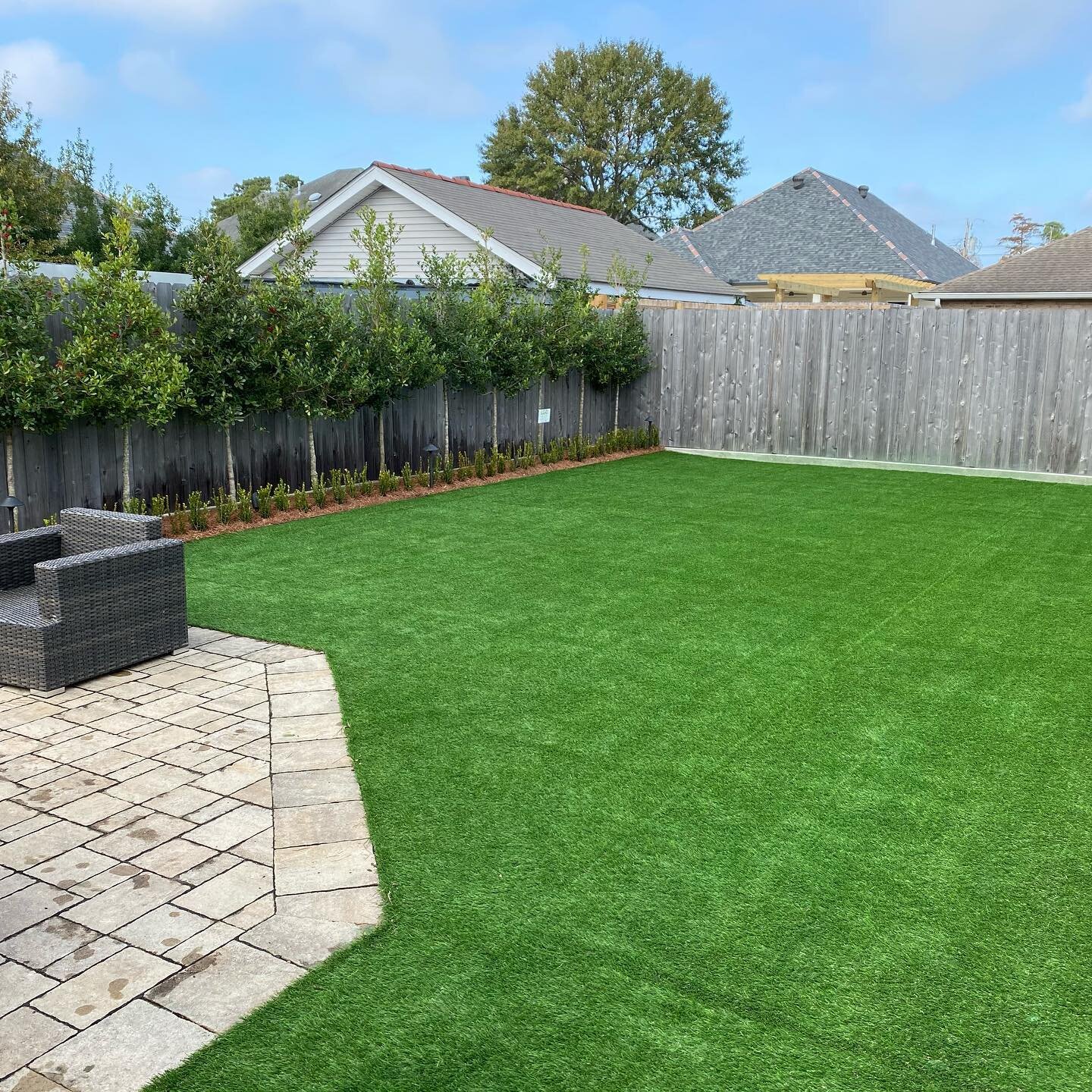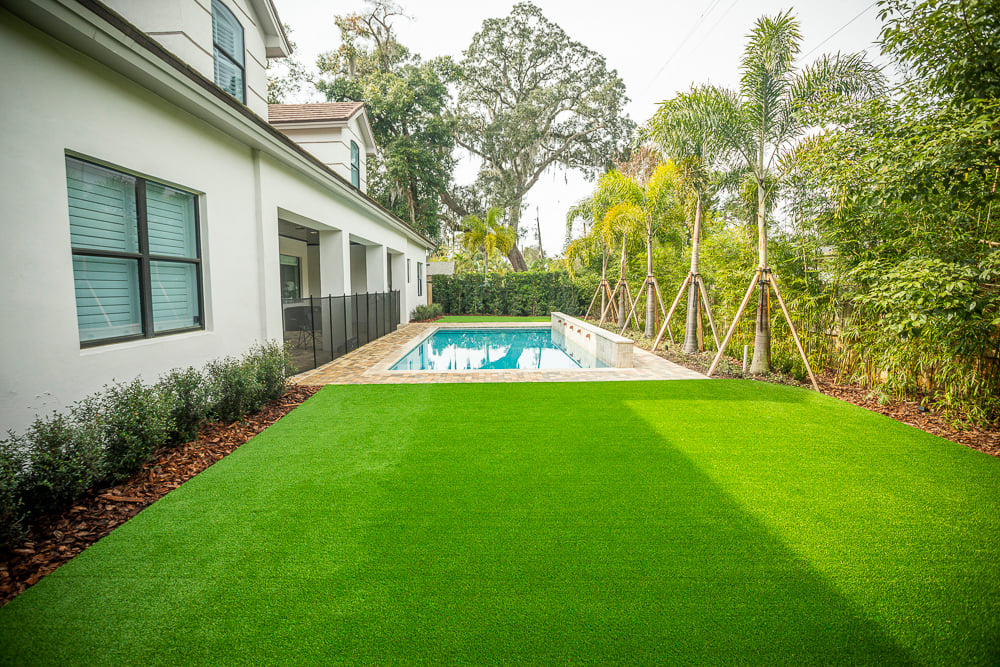Explore the Environmental Perks of Opting for Synthetic Grass Solutions
The fostering of synthetic lawn remedies provides an engaging possibility to deal with pressing environmental challenges. By considerably lowering water use and lessening the application of unsafe chemicals, these alternatives not only advertise lasting landscape design yet also secure neighborhood ecological communities. The reduced carbon footprint connected with lowered maintenance activities contributes to a much more sustainable approach to land administration. Nonetheless, the effects of these benefits extend past simple preservation initiatives, questioning about their lasting impact on habitat preservation and total ecological balance. Checking out these dimensions exposes a complicated interplay worth thinking about.
Water Preservation Conveniences
Among one of the most significant advantages of man-made lawn is its capacity to preserve water. Traditional lawn yards need considerable watering, particularly in locations vulnerable to dry spell or water limitations. In contrast, synthetic grass does not require watering, dramatically decreasing the general demand for water resources. This function is specifically beneficial in dry areas where water deficiency is a pushing problem.
By eliminating the need for normal watering, synthetic grass adds to sustainable landscape techniques and aids alleviate the ecological influence of too much water intake. Moreover, the preservation of water includes the reduction of overflow, which can result in dirt disintegration and river contamination.
Additionally, the setup of synthetic grass enables homeowners and districts to designate water sources much more efficiently, concentrating on important usages such as alcohol consumption water and farming. The shift towards synthetic grass not just promotes responsible water use but likewise straightens with more comprehensive ecological goals aimed at preserving all-natural resources.
As neighborhoods significantly prioritize sustainability, the water preservation advantages of synthetic grass offer a compelling instance for its fostering in business and domestic landscaping tasks.
Minimized Chemical Usage
The shift to man-made grass dramatically lowers the dependence on chemical treatments generally used in all-natural yard upkeep. Traditional grass monitoring normally involves the application of fertilizers, pesticides, and herbicides to advertise growth and control insects. These chemicals can present risks to human health, regional wild animals, and the environment, adding to soil and water contamination.
In contrast, man-made lawn eliminates the need for these unsafe substances. By lessening the release of artificial compounds right into the ecological community, man-made turf promotes healthier soil and water systems.
Additionally, the absence of chemical overflow connected with synthetic grass setups helps safeguard neighborhood rivers from contamination, supporting marine life and preserving biodiversity. Arizona turf. As neighborhoods progressively prioritize lasting methods, going with synthetic grass offers a practical option that straightens with environmental preservation objectives. Through this shift, residential property proprietors can take pleasure in lush environment-friendly areas without compromising eco-friendly wellness, leading the way for an extra lasting future
Lower Carbon Footprint

Furthermore, the installment of fabricated grass can result in substantial water preservation. Natural lawns call for substantial quantities of water for irrigation, which not just contributes to you can try this out the carbon footprint linked with water extraction and treatment but also strains neighborhood water sources. On the other hand, synthetic grass needs very little upkeep, needing no watering, thus significantly reducing water usage and its associated energy expenses.
Furthermore, the longevity of synthetic grass adds to its decreased carbon impact. With a life expectancy of up to 15 years or more, the need for regular substitutes is diminished, causing less waste and lower energy intake in production and taking care of traditional turf alternatives. Generally, synthetic grass provides a sustainable alternative for ecologically conscious landscape design.
Habitat Preservation
Habitat conservation is an important factor to consider in the discussion over landscaping selections, specifically when contrasting man-made lawn to natural turf. All-natural yard yards usually call for comprehensive upkeep, including making use of plant foods, herbicides, and pesticides, which can adversely influence regional environments. These chemicals can leach into the dirt and waterways, anonymous harming native plants and fauna and interrupting local environments.
On the other hand, synthetic grass presents a chance to minimize the eco-friendly impact of landscaping. By choosing for artificial turf, home owners can reduce the interruption of all-natural habitats connected with traditional lawn care practices. Synthetic lawn removes the need for harmful chemicals, therefore shielding nearby wildlife and maintaining the honesty of surrounding ecosystems. Furthermore, the installation of synthetic grass can cause the conversion of previous yard locations into more biodiverse landscapes, such as pollinator yards or native plant areas, which can sustain local wild animals.
Ultimately, the transition to artificial turf not only conserves water and minimizes maintenance efforts however additionally cultivates a much more harmonious partnership between human tasks and the native environment, promoting environment conservation while doing so.
Long-Term Sustainability
Lasting sustainability is an important factor in examining the benefits of synthetic grass over conventional yard lawns. One of the most significant benefits of artificial lawn is its sturdiness; it can last as much as 15-20 years with minimal maintenance, whereas all-natural grass requires constant reseeding and substitute. This longevity minimizes the demand for continuous resources, such as water, plant foods, and chemicals, which are vital for maintaining a healthy and balanced yard lawn.
Furthermore, artificial lawn adds to a decrease in carbon emissions related to yard care tools. Traditional lawns commonly need gas-powered mowers, leaners, and blowers, all of which add to air contamination. Phoenix turf companies. In comparison, fabricated lawn eliminates the requirement for such tools, click now promoting a cleaner atmosphere
In addition, the production of synthetic grass increasingly makes use of recycled products, boosting its sustainability profile. As manufacturers adopt environmentally friendly methods, the ecological footprint of man-made lawn continues to lessen.

Verdict
The fostering of fabricated grass services presents significant ecological advantages, including substantial water conservation, minimized reliance on harmful chemicals, and a lower carbon impact. Additionally, synthetic grass aids in maintaining natural environments by decreasing land disruption and advertising long-lasting sustainability via the use of durable products. Jointly, these elements highlight the potential of synthetic grass to contribute favorably to environmental health and wellness and use a practical choice to typical landscape design techniques in a progressively resource-conscious globe.
In comparison, synthetic lawn does not need watering, substantially reducing the overall demand for water resources. By reducing the release of synthetic compounds into the environment, fabricated turf advertises healthier dirt and water systems.
In addition, the installation of artificial grass can result in significant water conservation. In comparison, synthetic lawn requires very little upkeep, requiring no watering, consequently substantially minimizing water use and its associated energy expenses.
